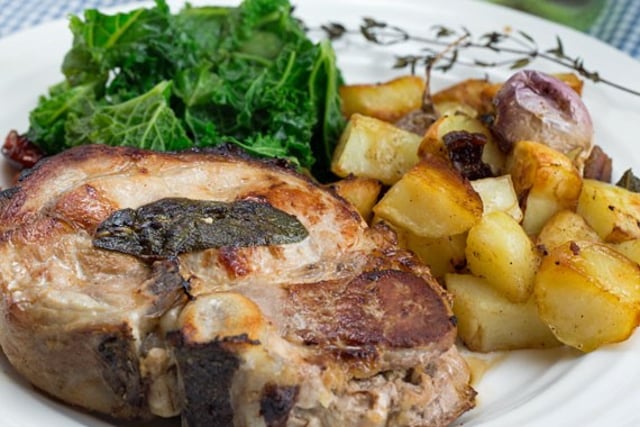Summary
Serves: 2
Preparation: 10 minutes
Cooking: 30 minutes
Tips
– If you can't get thick pork chops, don't try to stuff them with the apple and celery mixture. Instead, coarsely chop the ingredients for the stuffing and fry gently for 5 minutes or so and serve as a kind of sauce. For a bit more theatre, let the chops rest for 5 minutes after taking them out of the oven then flambé them at the table.
– If you haven't got any aquavit or snaps you can use brandy or simply eat the pork without flambéing. It is such a tasty dish anyway that the flambéing isn't really necessary: it just makes for a bit more fun!
Ingredients
2 thick pork chops on the bone, about 2.5cm (1″) thick
8 sage leaves
2 slices of prosciutto or other dried ham
1 clove of garlic, peeled and coarsely chopped
1 small apple, peeled, core removed, then quartered
1 stick of celery cut roughly into quarters
25g (1oz) butter
1 tsp olive oil
2 tbsp auquavit
little flour
salt and freshly ground black pepper
Method
1. Lay your pork chops on a board and then insert a sharp knife horizontally into the side of each chop, and cut through to the bone, to make a pocket in the side for the stuffing.
2. Put 1 tsp of olive oil in a sauce and a little flour in another saucer. Dip four of the nicest looking sage leaves in the olive oil to coat them on both sides and then press one side of each leaf into the flour. Press a leaf, flour side down, on to each side of the pork chop.
3. Put the remaining four sage leaves in a food processor along with the apple, butter, celery, garlic, prosciutto and a little salt and pepper. Give it a whiz until you have a lovely flavoured butter.
4. Divide the mixture between the two pork chops and stuff it into the pockets you have made.
5. Preheat the oven to 220°C (425°F, gas 7, Fan 180°C).
6. Add a teaspoon of olive oil to a pan and heat until it gets hot, almost smoking. Fry the chops for 5 minutes on each side until golden brown.
7. Transfer the pork chops to the oven for 10 to 15 minutes, depending on how thick they are, then remove from the oven.
8. Pour a tablespoon of aquavit over each chop and set alight. When the flames have died down, let the chops rest for 5 minutes before serving.
Serving suggestion
This dish goes well with roast potatoes with bacon and sage. In this case you can simply place the pork chops on top of the potatoes after they have been in the oven for 15 minutes or so. I also like to add some nice kale and/or slow roasted tomatoes.
Recipe courtesy of John Duxbury, founder and editor of Swedish Food.



 Please whitelist us to continue reading.
Please whitelist us to continue reading.